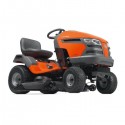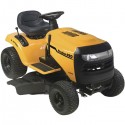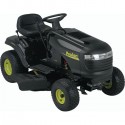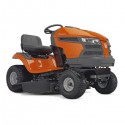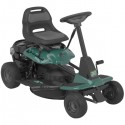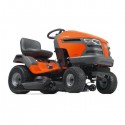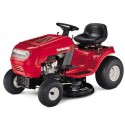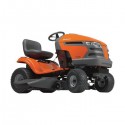Garden or Lawn Tractor Buying Guide
These are the 8 best garden or lawn tractors based on product quality, customer satisfaction, and price:
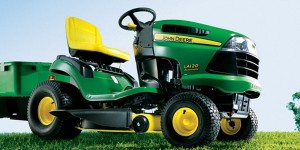 One of the most important aspects of maintaining a well kept property is making sure your lawn always looks its best. This means spending a lot of time and energy laying sod or planting seed in patches where the lawn has died back, making sure the grass is always getting all the water it needs, keeping weeds like dandelions and crab grass at bay, and periodically fertilizing the lawn to make sure it is getting all the nutrients it needs to remain lustrous and verdant.
One of the most important aspects of maintaining a well kept property is making sure your lawn always looks its best. This means spending a lot of time and energy laying sod or planting seed in patches where the lawn has died back, making sure the grass is always getting all the water it needs, keeping weeds like dandelions and crab grass at bay, and periodically fertilizing the lawn to make sure it is getting all the nutrients it needs to remain lustrous and verdant.
But perhaps most important to keeping a good lawn is making sure you are cutting it regularly. No one likes the look of a messy, overgrown lawn. But mowing your lawn is probably the one aspect of lawn care that will use up the most of your time, and so it is in your best interests to make sure you are minimizing the labor and time required for this task.
One of the best machines for this task is the lawn tractor. Lawn tractors are big and burly, and they can cut extremely wide swaths of grass at once that are over three feet wide in some cases, which can significantly reduce the number of passes needed to mow your lawn. In addition to that, a lawn tractor is a vehicle – you ride it as you cut your grass. There are a number of things to look for when you are shopping for a lawn tractor.
First among these is the machine’s deck size, or width of the cutting swath. Next you will want to consider what other chores you might be using your lawn tractor for, and whether you should purchase a garden tractor or one that has different attachments for other tasks. Grass clipping management options also come into play when you are shopping for a lawn tractor, and finally, you will need to think about specifications such as horsepower and torque, and whether you want a mower with a zero turn radius.
That is a lot to keep track of, and it is understandable if it feels nearly overwhelming. But shopping for a new garden or lawn tractor doesn't have to be a chore. This guide will walk you through all of the different things to think about when you are shopping for a lawn tractor, and after you have read it, you should be fairly confident that you will make the right choice for your needs.
1. Garden / Lawn Tractor is a Good Buyer’s Choice
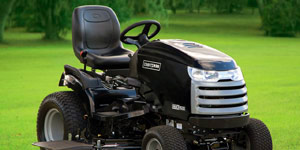 The major advantages to buying a lawn tractor are the extremely wide deck size it offers, and the fact that a lawn tractor is a kind of riding mower. Both of these mean you will be able to cover far more ground, and do so in much less time, than you would be able to with a walk behind or push mower. If you are the owner of a particularly large property that is more than half an acre, you probably have a lot of grass to cut. In this case, a lawn tractor is the right choice for you.
The major advantages to buying a lawn tractor are the extremely wide deck size it offers, and the fact that a lawn tractor is a kind of riding mower. Both of these mean you will be able to cover far more ground, and do so in much less time, than you would be able to with a walk behind or push mower. If you are the owner of a particularly large property that is more than half an acre, you probably have a lot of grass to cut. In this case, a lawn tractor is the right choice for you.
A lawn tractor also has the added advantage of offering a number of options that are not necessarily related to lawn care. Many manufacturers offer garden tractors. These come with attachments that can be used to work the soil, either tilling it to get it ready in the spring, or digging furrows for planting vegetables. If you are a serious gardener, a garden tractor can be a great choice.
Besides that, the majority of lawn tractors offer other attachments for leaf collection, snow removal, and distributing grass seed or fertilizer on your lawn. If you are the owner of a property with a lot of trees, or if you live in a region that gets a fair amount of snow fall every winter, or if you simply have a very large lawn that requires weed killer or fertilizer distribution, these are great options that walk behind lawn mowers simply do not offer.
A lawn tractor takes a lot of the work out of maintaining a large lawn, and because of this they are almost a “must have” item for property owners who have an acre or more to care for. It is virtually impossible to take care of a lawn that is over a half an acre without a lawn tractor. Spreading seeds and fertilizer manually and cutting the grass with a walk behind mower just takes far too long. A lawn tractor takes much of the time and labor involved in these chores out of the equation, and allows you to get the job done in a reasonable amount of time. That means you will be able to enjoy your lawn sooner, and taking care of it will become downright enjoyable.
2. Garden / Lawn Tractor Buying Specifications
2a. Deck Size
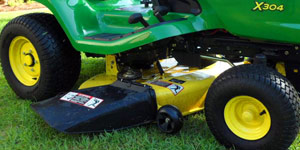 The first thing you will need to look at when you are shopping for a lawn tractor is the deck size, or width of the cutting swath, that it offers. Lawn tractors offer huge deck sizes – typically between 38 and 54 inches (between three and five feet) – when compared to walk behind mowers, which don’t even begin to stack up. The larger deck size allows you to cut a big lawn in fewer passes, which means you will be spending less time on the job and on your way to relaxing much more quickly.
The first thing you will need to look at when you are shopping for a lawn tractor is the deck size, or width of the cutting swath, that it offers. Lawn tractors offer huge deck sizes – typically between 38 and 54 inches (between three and five feet) – when compared to walk behind mowers, which don’t even begin to stack up. The larger deck size allows you to cut a big lawn in fewer passes, which means you will be spending less time on the job and on your way to relaxing much more quickly.
But simply looking for the widest deck and calling it a day is not always the best option. A lawn tractor with a deck size that is almost five feet wide might be too big for your needs. If you are mowing an open field with no obstacles, going for the widest deck size makes perfect sense, because you will simply be able to drive back and forth on it with no trouble.
But if you have a lot of trees on your property, or a grove of closely growing trees, or pathways with narrow strips of lawn between them, a huge deck size might not be ideal. Therefore you have to shop for a deck size that maximizes the speed at which you can cut your lawn, but is also conservative enough to deal with any obstacles or narrow spots on your property.
A lawn tractor that has a very wide deck size will also necessarily be a bigger machine, which means it will require more space for storage. So you have to keep this in mind when you are shopping for a lawn tractor as well: is it going to fit in your garage or barn? Make sure you buy a lawn tractor with a deck size that will.
2b. Garden Tractors vs. Lawn Tractors
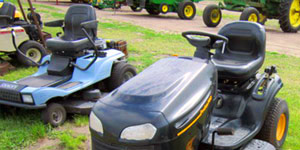 Next, you will have to consider whether you want to buy a garden tractor. Unlike standard lawn tractors, garden tractors offer additional capabilities for working the land with tasks such as tilling soil or digging furrows for planting. Garden tractors typically have more horsepower than standard lawn tractors, and have a more compact frame than standard lawn tractors, but also weigh more.
Next, you will have to consider whether you want to buy a garden tractor. Unlike standard lawn tractors, garden tractors offer additional capabilities for working the land with tasks such as tilling soil or digging furrows for planting. Garden tractors typically have more horsepower than standard lawn tractors, and have a more compact frame than standard lawn tractors, but also weigh more.
The higher power on a smaller vehicle means that a garden tractor can easily maneuver over larger, more rugged lawns without any trouble, whereas a standard lawn tractor might struggle with that kind of terrain. For the same reason, a garden tractor will be better if the land you are mowing is particularly hilly: they will maneuver up and down hills with relative ease compared to a standard lawn tractor.
A garden style tractor is designed for heavy duty work like grading or tilling the land, and it can pull a trailer with a heavier load than a standard lawn tractor can. For these reasons, if you are very serious about gardening in addition to general lawn care, or have a mini farm in your backyard, a garden style tractor might be better for you.
But you should keep in mind that garden style tractors are typically a lot more expensive than standard lawn tractors, and generally range from $2000 to $9000. A standard lawn tractor, on the other hand, will typically only run you between $1000 and $3000. Therefore you should carefully consider your needs before you spend more than you have to.
2c. Attachments
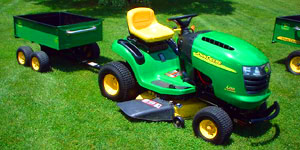 The typical lawn tractor offers a number of different attachments that allow it to be a much more versatile machine that can perform quite a few tasks other than just cutting the grass. There are lawn tractor accessories available from various manufacturers that collect leaves, plow snow, aerate the turf, and distribute weed killer and grass food. The majority of these accessories are sold separately, but there are some manufacturers who offer certain accessories as part of the initial purchase price.
The typical lawn tractor offers a number of different attachments that allow it to be a much more versatile machine that can perform quite a few tasks other than just cutting the grass. There are lawn tractor accessories available from various manufacturers that collect leaves, plow snow, aerate the turf, and distribute weed killer and grass food. The majority of these accessories are sold separately, but there are some manufacturers who offer certain accessories as part of the initial purchase price.
If you are already looking into whether you should buy a lawn tractor, it is likely that you have a fairly big property that is more than a half acre in area. If that is the case, these additional tasks can be almost as daunting as cutting the grass is. Who really wants to rake up a half acre of leaves by hand? A task of that size would take more than a couple of days and leave you worn out and never wanting to look at another leaf again. Similarly, distributing lawn food over a half an acre with a manual spreader would take hours and be highly impractical.
So in all of these cases, it is a very good idea to take a look at the various accessories that are offered for different lawn tractors and select one that can perform the widest array of tasks. This will help to considerably cut down on the amount of time you spend on basic lawn care tasks, which has several benefits: you will have more free time, but you will also be more inclined to take care of your lawn than you otherwise would, which means it will be healthier and better cared for.
2d. Automatic and Hydrostatic Transmission vs. Manual Transmission
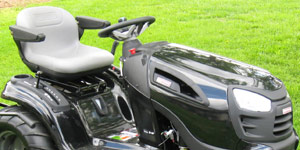 A lawn tractor that is equipped with an automatic or hydrostatic transmission will be a lot easier to maneuver than a lawn tractor with a manual transmission. A lawn tractor with a manual transmission has to come to a full stop every time you want to change the gears, whereas an automatic or hydrostatic transmission can seamlessly change from one gear to the next while in motion. This can be an important concern if you are going to be using your lawn tractor on hilly terrain or numerous garden beds to maneuver around, as that will require you to be changing gears often.
A lawn tractor that is equipped with an automatic or hydrostatic transmission will be a lot easier to maneuver than a lawn tractor with a manual transmission. A lawn tractor with a manual transmission has to come to a full stop every time you want to change the gears, whereas an automatic or hydrostatic transmission can seamlessly change from one gear to the next while in motion. This can be an important concern if you are going to be using your lawn tractor on hilly terrain or numerous garden beds to maneuver around, as that will require you to be changing gears often.
Hydrostatic transmission is the most common form of automatic transmission available on lawn tractors today. Hydrostatic transmissions are powered by hydraulic fluid instead of gears or disks, which means they are able to provide more torque to the wheels compared to mechanical transmissions. But hydrostatic transmissions are also typically more expensive than mechanical transmissions up front; however they are less inclined to break down, which will save you money on repairs in the long run.
2e. Mulching and Bagging Kits
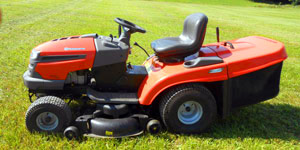 As with all lawn mowers, different lawn tractors on the market will have different options for grass handling. The least expensive option is a lawn tractor that simply discharges grass clippings out the side and offers no other options. However you may want to bag your clippings for disposal or to put in your compost pile; or you might want to mulch the grass clippings back into the lawn periodically.
As with all lawn mowers, different lawn tractors on the market will have different options for grass handling. The least expensive option is a lawn tractor that simply discharges grass clippings out the side and offers no other options. However you may want to bag your clippings for disposal or to put in your compost pile; or you might want to mulch the grass clippings back into the lawn periodically.
It may also be the case that you typically bag your front lawn for aesthetic purposes, but don’t mind discharging the grass clippings out the side in a field in the rear of your property that is only seen by your family when you are playing catch with your kids. If this is the case, you are going to want to find a lawn tractor that offers different grass management options.
As with any accessory to a lawn tractor, mulching and bagging kits are typically sold separately, and can range widely in price. There are also different options within these categories: do you want a lawn tractor that collects clippings in a single bag or in two side by side bins? Each of these options is going to have a different price tag.
Because of this it is important to carefully consider which options you want available to you and weigh that against how much beyond the initial sticker price you are willing to spend on a lawn tractor. Then, you should shop around competitively to make sure you are getting the best deal for the accessories you want.
2f. Horsepower, Engine Size, Torque and Turning Radius
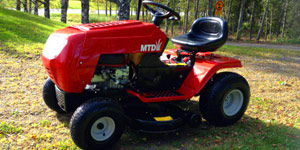 Every lawn tractor on the market is going to have a slightly different combination of horsepower, engine size, torque, and turning radius. Aside from transmission style, these four areas are the major functional considerations to a lawn tractor, and you will need to carefully consider the pros and cons of prioritizing each one over the others.
Every lawn tractor on the market is going to have a slightly different combination of horsepower, engine size, torque, and turning radius. Aside from transmission style, these four areas are the major functional considerations to a lawn tractor, and you will need to carefully consider the pros and cons of prioritizing each one over the others.
Horsepower is going to determine how strong your lawn tractor is. This will affect its ability to cut a large area of very thick grass such as St. Augustine or Bermuda grass. It will also affect how much towing power the lawn tractor has, and if you are opting for an accessory such as a snow blower or snow plow, the machine’s horsepower will affect its ability to maneuver through and deal with deep, wet snow. If you are looking into purchasing a garden tractor that you intend to use for grading the land or tilling the soil, horsepower will be a major consideration.
Engine size directly affects the horsepower and torque a lawn tractor offers, but it also affects the amount of gasoline the machine requires and the size of the lawn tractor. Larger lawn tractors require more storage space and do not maneuver as well through narrow spaces or around obstacles.
Larger tractors also have a wider turning radius, which can make it difficult to move seamlessly from one row to the next in a single turn. But a more powerful engine will be able to perform harder tasks, have less trouble dealing with rough or hilly terrain, and will cut a larger area without refueling.
The amount of torque the lawn tractor has will also affect its performance, and it should be considered in tandem with engine size and horsepower. Torque defines the rotational power of the machine’s engine, and so it is a good measurement of the lawn tractor’s ability to perform tasks such as cutting thick, dense grass or plowing through deep, wet snow. Many consumers ignore torque because they are more familiar with horsepower as the common designation of an engine’s power, but it is a wise move to get familiar with the torque on different machines.
Finally, you should consider the turning radius of the lawn tractor you are considering buying. Turning radius will be affected by engine size and deck width as well as whether the lawn tractor is rear wheel or all wheel drive. To some degree the importance of turning radius is a matter of personal opinion, but it can be important if you want to make tight turns at the end of rows in order to double back on or overlap with cut grass.
These are the 8 best garden or lawn tractors based on product quality, customer satisfaction, and price:

